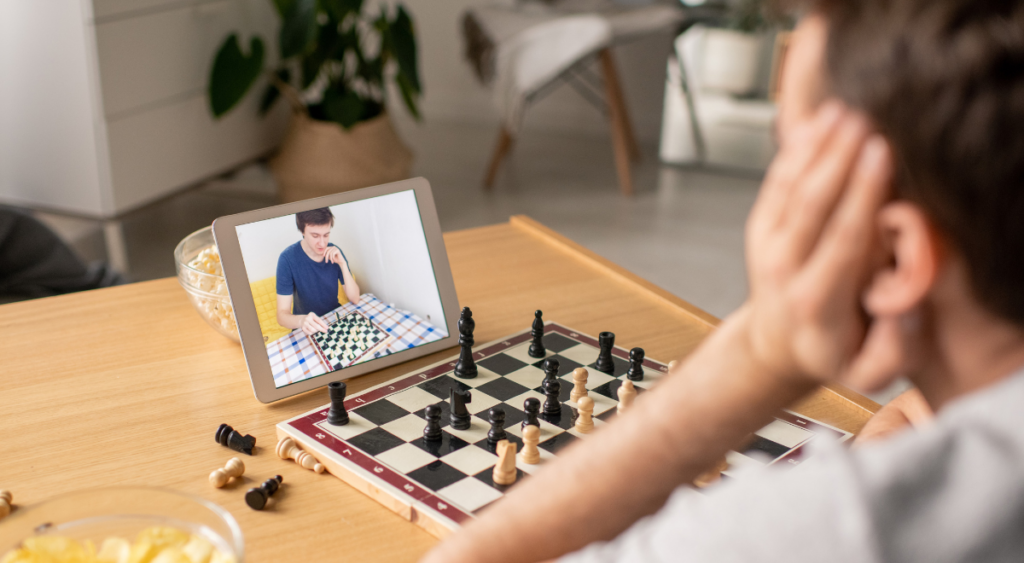What is gamification?
The Oxford Dictionary defines gamification as, “the application of typical elements of game playing to other areas of activity.” As an online educator, this means using interactive games in your online classroom to heighten the learning experience and keep learners engaged — no matter what subject you teach.
In this article, we’re going to discuss:
- How to use gamification in your online classroom
- The benefits of using games for learning and retention
- 10 ways you can include games in your classes

Using gamification in the online classroom
One of the challenges online educators face is keeping learners engaged and interacting during class. Since learners are at home, or maybe even at the library or in a car, many distractions may be pulling their attention away from the classroom. That’s why it is so important to make learning fun and engaging.
Gamification is one way that educators can make this happen! Here’s how:
Strengthen learning
With games, educators can make learning engaging and interactive or even help cement facts, figures, and ideas in their learner’s brains. According to the eLearning Industry, using games as part of your teaching “provides learners with a sense of achievement and encourages learner progression.” Knowing this, you can create challenge-based or results-oriented learning games that help learners grow in a virtual environment.
Showcase results
By providing instant feedback, both educators and learners can see what’s working and what’s not. As an educator, you can quickly identify what learners know well, areas the class needs additional support with, and what concepts are still over their heads. Doing so can help educators focus on how to offer new concepts during upcoming classes or decide where to strengthen the material for next time.
For some learners, seeing their results in real-time allows them to use that information to review or study the areas that they are struggling with. Sometimes, the repetitive nature of a game can help learners grasp a concept they cannot understand when listening to a lecture.
Provide rewards
Of course, learners love gaming because games are fun! Whether your class is playing online trivia, bingo, or a matching game, getting involved as a group during class time makes the whole experience more enjoyable. You can even reward learners with a game at the end of class, but be sure to let them know in advance if they need to have a second device ready or a tab open before class. (Nothing is more frustrating to a learner than feeling unprepared in front of their peers.)

10 ways to use gamification in your online classroom
Using games in your virtual classroom doesn’t always have to be just for fun. Playing games in an academic environment promotes learning, emphasizes new ideas, and helps learning retention.
Below are 10 ways how teachers use it to keep kids engaged, entertained, and learning using games.
Achievement or Completion Badges
Celebrating small wins can mean big results in the virtual classroom. That’s why virtual badges or badges learners can print at home have become such a hit at Outschool. Adding achievement or completion badges gives young minds a boost of pride for their efforts. And what better way to show learners that you see their successes than with a tangible reward?
These are also great motivators in an asynchronous environment such as Flex courses, as they may encourage continued participation over time. For example, you could offer a weekly badge for completing assignments or videos and have learners collect them all during the course for a more significant badge at the end.
Examples of online learning badges:
Trivia Games
Challenging learners to remember something taught during class time used to mean a paper quiz or being called on in front of everyone. For some learners, this type of learning can seem overwhelming and maybe even embarrassing. To combat this, game creators have found a way to evaluate learners without putting them on the spot.
Enter trivia games!
Not only does trivia test out your class’s understanding of what they learned, but you can also pull reports afterward to see what areas need improvement. Offering a trivia game at the beginning of class can help you tailor your teaching to those areas that need additional help. On the other hand, enjoying a trivia game at the end of class may create more engagement and questions during class if the learners know it is coming.
Examples of trivia games to include in your online classroom:
For those who prefer offline games, you can create bingo cards, use brain games, or create polls in the Zoom chat to enhance your lessons.
Storytelling
Stories are more than just the words we read in books. In fact, educators on Outschool have long used storytelling to teach a variety of topics. Using stories in the classroom opens learners up to learning about other cultures and perspectives through the words of multiple individuals. It strengthens communication when learners create stories filled with details and powerful words.
Of course, storytelling does not always have to be from a book. It can be in the form of a play, a poem, or even a rap battle. Storytelling is also a fantastic way to teach with a diversity-focused mindset. Many cultures are oral cultures where learning takes place through storytelling rather than the more American or European methods of learning that we consider traditional. The goal is not in how the story is told but in the words and ideas shared.
For more information on how to use storytelling as an interactive tool in your classroom, be sure to check out these articles:
- Storytelling in the classroom as a teaching strategy
- Why storytelling in the classroom matters
- Twelve ways to integrate storytelling in the classroom
Scavenger Hunts
Scavenger hunts are a huge hit for little learners, but did you know that learners of all ages enjoy the hunt? Not only do they allow learners to interact with each other, but each learner can share their findings with their peers. This type of learning also allows learners to problem-solve when an item isn’t available, come up with creative ideas, or even work together to help their classmates succeed.
But don’t think scavenger hunts are limited to finding physical objects around the house. You can also create a scavenger hunt with books using quotes, characters, or setting clues. If you teach math, use longer word problems to show how to “find” the important information in each problem. An English educator may have learners find certain letters throughout a book to spell a name or solve a mystery.
If you haven’t tried a scavenger hunt yet, use the following ideas to get you started:
- 20 Zoom scavenger hunt ideas for teachers – online learning
- 40 Creative free scavenger hunt ideas for kids
- Top 12 virtual scavenger hunt games
Hands-on learning activities
Instead of lecturing for the entire class time, consider using gamification to implement an “I Do, We Do, You Do,” learning methodology. In this situation, you provide instruction on how to perform a task or teach an idea first (I Do). Next, you work together with learners so that they can try it out with your support (We Do). Finally, learners work independently (You Do).
With hands-on learning games, you can help improve your learners’ understanding of a subject as they work on it at home. Learners can follow along as they create slime, construct a toothpick bridge using only the number pulled from a stack of cards, or draw a monster using details written on paper picked out of a hat.
Looking for games you could add to your online classroom? Consider playing games such as Battleship for coordinate grids, Guess Who? for character descriptions, or virtual strategy games for collaboration.

Escape rooms
Did you know that you can create escape rooms virtually? You can build your own escape rooms using a couple of tools such as Google Slides and Google Forms and create your own today. You can even use platforms such as Breakout EDU to search to create an online challenge. (Options include a paid and a limited free version.) But how can an escape room help in the classroom?
We’re so glad you asked!
Escape rooms are known for their challenging tasks, clues, and victorious triumph when you and your team beat the clock. In an online classroom, using escape rooms cultivates a sense of teamwork and collaboration. Learners have to communicate with each other, think through the problems, and ultimately solve them as a group. Escape rooms also allow learners to solve clues based on what they learned in class, which can help you see how well they comprehend the material.
Ready to build your own escape room? Learn how with these guides:
- 10 Easy steps for creating fun virtual escape rooms
- Room Escape Maker – Create escape rooms
- How to make an escape room in Google Forms
Immersion
If you’re a language educator, you probably already know the benefits of immersion. Numerous studies have shown that language immersion increases language proficiency significantly faster than just learning from a book. There are immersion activities and games that you can use for other topics and subjects.
For example, if you offer math classes you may be able to fully immerse learners into the problem by presenting it as a story, giving learners a real-world problem to solve, or using candies to count or multiply. A physics educator may have learners build their own backyard rollercoaster to teach velocity and acceleration.
Of course, an English educator may have students listen to an audiobook while following along with the words in their own book to enhance the experience. Educators offering history or cultural classes can share movie clips, regionally or culturally specific music, and foods, allowing learners to step fully into another culture.
- Teaching mathematics through immersion
- How Minecraft impacts learning
- Play Scrabble online in another language
Simulations
Reading and learning about historical people and dates is a lot of fun, but what if you could level up your history classes with simulations? Maybe you teach math and you know that teaching shapes and angles is easier when learners can see the shapes instead of just imagining them.
Using simulation games in the online classroom allows students to jump into a scenario or move objects around so that they are more than 2D drawings. They also allow learners to take part in science experiments that they could only do in a controlled lab environment.
Examples of online learning simulations:
- PBS Mission US interactive narrative games
- Math simulation games
- PhET: Free online physics, chemistry, biology, and other science games
Role-playing
Have you ever considered making book club characters or historical figures come to life? According to Northern Illinois University, role-playing in the classroom can help motivate and engage students, provide real-world scenarios, and learn skills such as negotiation and debate, teamwork, and other skills when used to enhance your lessons.
For example, Dungeons and Dragons offer learners the chance to create their own characters and settings while creating an adventure for their character to go on. As an English Language Arts educator, this may be the perfect way to break out the elements of literary analysis.
Just remember that sensitive topics should not be taught in a role-playing format. If you’re unsure about what would be considered inappropriate role-play, please be sure to read Outschool’s guidelines for role-playing.
Exit tickets
As your class wraps up, you have the perfect opportunity to create a fun, engaging environment with your learners with an exit ticket game. Not only is this a memorable way to end your lesson, but it is also a wonderful tool to assess what learners are understanding and what areas need additional support.
Games may include any of the options listed above, or you can create your own games such as matching, rating systems, or prompts using Google Slides, Nearpod, or Padlet.
Remember, when using third-party tools in the online classroom, you need to ensure that families are aware of what if any, data is being collected. Before you commit to a game or platform, check out Outschool’s list of approved and unapproved external teaching tools.
If you’re new to creating exit tickets, be sure to check out these ideas to get you started:
- 20 ideas for exit tickets in the classroom
- 21 ways to use exit tickets in every kind of classroom
- 60 digital exit tickets for teachers
One final note
Now that you know how gaming can elevate your learner’s in-class experience, it’s time for you to give it a try. Consider using one of the above ideas in your online classroom.
For more tips, tricks, and strategies be sure to check out Outschool’s Educator Library.

